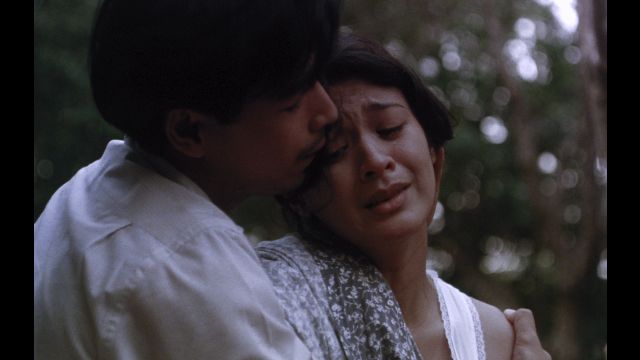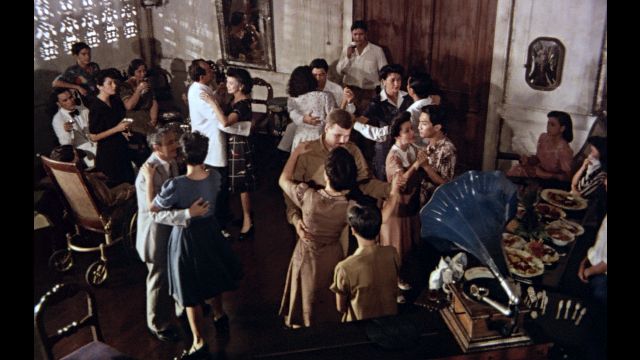SUMMARY
This is AI generated summarization, which may have errors. For context, always refer to the full article.

MANILA, Philippines – In what has been a pretty big year for Philippine cinema, one of the country’s monster movies comes out of pre-millennial slumber for a digital spruce-up.
Of course, Oro, Plata, Mata (Gold, Silver, Death) is not a monster movie in the traditional, B-movie sense but rather a big movie with a 3-hour-15-minute sprawl, all the better to fully realize a raw yet compelling depiction of human devolution during World War II Philippines.
Nicks nixed
Oro, Plata, Mata was first released in 1982, and what better way to celebrate its 30th anniversary than with a grand coming-out party replete with digital restoration, as last Wednesday’s opener of the Cinema One Originals Festival 2012.
Credit for the film’s Internet-era resurrection goes to the ABS-CBN Corporation, which has undertaken the effort of saving Pinoy cinema classics by providing proper, air-conditioned storage space, and to the outfit named Central Digital Lab, which undertook the mammoth task of converting the 195-minute opus from its original film format to digital.
Per Oro director Peque Gallaga, speaking at the joint festival launch and restored-movie premiere last November 28, the remastering took 1,700 hours of work by 16 people.
Gallaga added that Central Digital Lab has 2,000 films in all to restore, joking to the effect that even the Lab management’s great grandchildren would keep working on them.
On the surface, viewing the digitally restored Oro would not yield any obvious changes.
In Oro’s case, the picture quality is still largely of its pre-digital time but it has been rid of whatever scratches its master rolls of film may have had.
Thanks to its new format as well, gone too are the upper-right-corner cue marks that used to alert projectionists in switching between reels, not to mention that Oro is now easier to archive and no longer prone to elemental corrosion.
Fools’ gold

The digital restoration of Oro, Plata, Mata, affords not just a refreshing look-see at this infamous gem of Philippine cinema but also encourages some engaging reflection.
At the launch held at Robinsons Movieworld Galleria, the 69-year-old Gallaga was his ever candid self, citing through his sh*t and drugs-citing speech how Oro was a “project made by fools. Had we known what we would be getting into, we might not have done it.”
Its epic length was of course a primary issue, but then “[scriptwriter Jose Javier Reyes] gave us a 5-hour script with that great title.”
In a quick chat with Rappler close to midnight that evening, Reyes, who has gone on to make compelling films of his own, shared that, “Other than Peque asking me to do it, what inspired me to write this movie were stories I learned from my father, Marciano Reyes Sr., about the so-called peacetime and how we Filipinos were never really the same after the War.”
Originally presented by the now-defunct Experimental Cinema of the Philippines and the Philippine National Bank, Oro was shot entirely in Negros Occidental, and Gallaga made mention on premiere night of the Bacoleños’ generosity and cooperation throughout the film’s arduous shoot.
He also attributes Oro’s against-huge-odds success to having “worked with gifted people,” including thespians and crew members who have passed on, such as cast members Mary Walter and Abbo De La Cruz, and those who are around, such as premiere attendees Cherie Gil, Liza Lorena, Fides Cuyugan-Asencio, Jaime Fabregas and Manny Castañeda.
The filmmaker was likewise generous enough to acknowledge the nameless array of actors who can be seen during the “scrapbook” sequence of Oro’s opening credits.
“So this night is a double tribute to an artistic generation,” the director stated.
As the remastered masterwork unspooled, it was also as if you were watching two movies in one: the film as it is and as an inadvertent, multi-level documentary, of a circa-1942 era and an early-’80s period marked by daring filmmaking and, on the side, durable performers in lighter, less wrinkled states.
Crazy beautiful

Detractors would still have a field day dismissing Oro, Plata, Mata, riddled as it is with technical imperfections and artistic predilections.
Yet viewing it now, as best savored in the darkened splendor of the moviehouse, there is no mistaking the film’s potent amalgam of drama, realism, mystique and grandeur.
It manages to be by turns introspective and outlandish as it essays the bad-to-worse-to-WTF impact of the Japanese occupation on a Filipino clan of masters and servants.
Be it due to budget constraints or creative decisions, Gallaga also deserves kudos for not doing a George Lucas, by not corrupting his own work with distracting added footage.
One can argue that the movie’s scattered array of certain in-your-face moments could have been dispensed with — from Maya Valdes as a doctor tending to blood-spurting war victims to Valdes waterfall-bathing in her birthday suit, from the carefree nudity of Ronnie Lazaro to Cherie Gil as a precocious lass willfully deflowered care of Lazaro’s mute male, from the gutting of a pig for a feast to the blowing of someone’s brains to bits.
Yet such elements not only help lend the film its raw power, they also aid in immersing the audience into the fascinating life and horrible times of its made-up yet based-on-real-life characters.
Added oddities

In telling a full-fledged story of how both profoundly cruel and affecting war is and how we can be our own enemies, Gallaga also managed to find room to insert an oddity or two.
For one thing, there was a deliberate effort to show just one Japanese character in this WW II-set flick, a wounded, weakened one at that, in a bit of enemy-as-enigma scheme that predates Steven Spielberg’s Saving Private Ryan.
And in a special bit that has had its own cult following, singer Kuh Ledesma appears, sans any lines, as a mysterious, slow-walking figure whose presence is left to unforgettable ambiguity. (This also makes Ledesma, per Oro, Plata, Mata’s initials, an “OPM” artist twice over.)
Film pundits could even take note of what is perhaps the most memorable line off Oro, when Cherie Gil hisses to the surreptitious sister played by Sandy Andolong, “Hayop din ang ahas, ’di mo ba alam?” (“The snake is an animal too, don’t you know?”) — an emotional barb that turned out to be a pre-“You’re nothing but a second-rate, trying-hard copycat” omen of Gil’s quotable career.
Endearing, entertaining, enduring

Oro, Plata, Mata can also be seen as the epitome of delicate balances — of how it is a feast for the eyes yet also shrewdly opts to narrate instead of show certain details (via the talky matron portrayed by Lorli Villanueva), of sensibility versus insanity amid terrible predicaments, and of how life’s pristine beauty can prevail even amid mankind’s atrocious tendencies.
While Oro is about a distant era, it is actually an echo of its production’s own time, an era that had seen the country itself going from bad to worse anew, by then due to Martial Law.
That Oro will now get to outlive its creators and viewers is a welcome development, one that should not only make the film a window to two past eras — the early ’40s story-wise and the early ’80s production-wise — but also a stimulus for future filmmakers, writers, actors and other cinema workers.
And that we the audience are still eager to discuss it, warts and all, is clear testament to how Oro, Plata, Mata is good, grim, great. – Rappler.com
‘Oro, Plata, Mata’ will be shown anew during the ongoing Cinema One Originals Festival 2012 on December 2, 3 pm, at the Edsa Shangri-La Cineplex. It has been rated R-16 by the incumbent MTRCB.
Add a comment
How does this make you feel?
There are no comments yet. Add your comment to start the conversation.